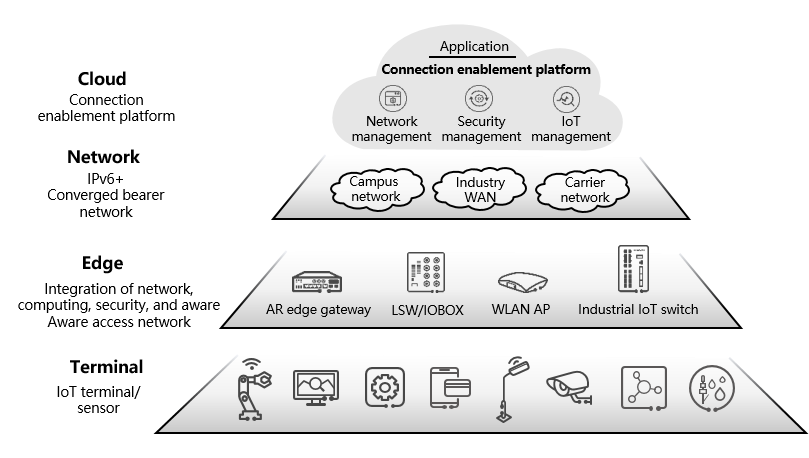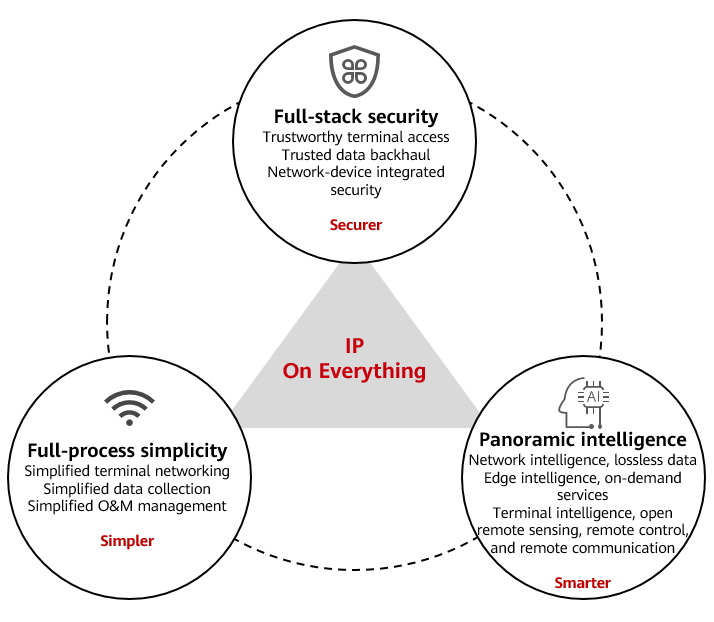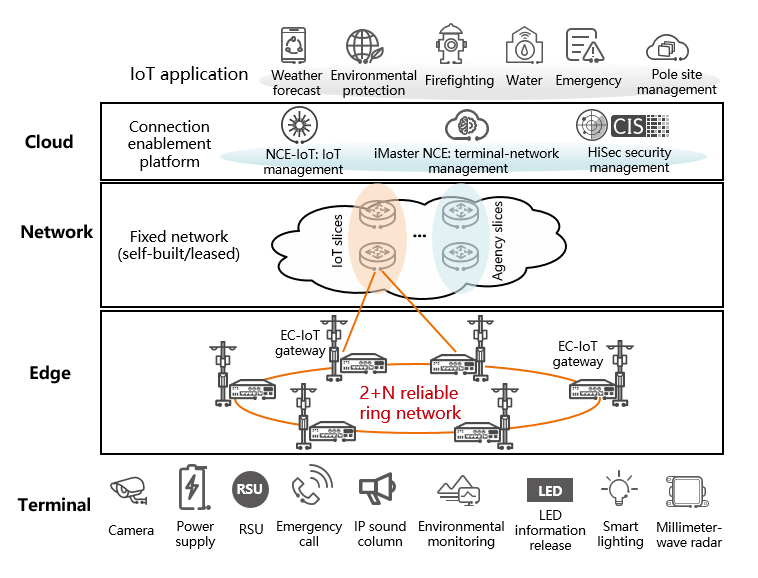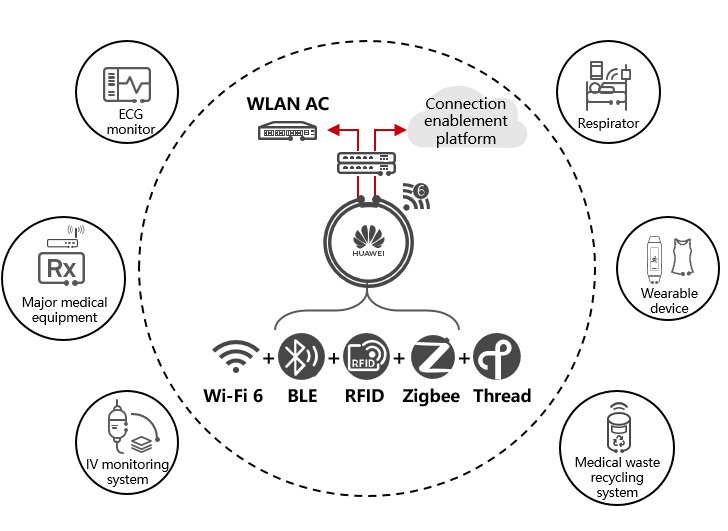What Is IoT Aware Network?
IoT Aware Network connects various types of IoT terminals with different functions and forms to the edge computing (EC-IoT) gateway. The EC-IoT gateway interworks with the cloud platform through a backhaul network to sense, transmit, and process information in the physical world and implement collaborative control on terminals and sensors. In this way, IoT Aware Network meets digital transformation requirements of various industries, and the production, life, and social management modes are transformed towards the intelligent, refined, and network-based direction.
Why Is IoT Aware Network Needed?
IoT promotes sustainable development of digital economy
Human society has experienced the development phase from "agricultural economy" to "industrial economy". Now, it is moving towards a new era of "digital economy" represented by technologies such as AI and big data. As an important part of the next-generation information infrastructure, the IoT has become the key to digital economy transformation. With digitalization and intelligence as the development direction, the future-oriented IoT aims to eliminate information silos and data fragmentation, implement ubiquitous interconnection and efficient communication of digital information, and promote sustainable development of the digital economy.
IoT Aware Network becomes a hotspot for IoT construction in the industry
In 2009, the concept of "Sensing China" ushered in a new era of IoT development in China. In recent years, in application scenarios such as smart city, smart transportation, smart healthcare, smart water conservancy, and smart energy, IoT Aware Network in the forms of fields, stations, and regions has become a hotspot in IoT construction. IoT Aware Network is a communication network that uses awareness and communications technologies. Multi-source heterogeneous terminals and edge IoT gateways in a specific industry scenario form IoT Aware Network onsite and collaborate with each other to sense, transmit, and process information in the physical world.
IoT Aware Network is capable of sensing terminal access, network status, and security situation and ensure secure, reliable, and low-latency network communication. In addition, a unified IoT and cloud IoT platform are built to promote digital transformation of services. Nowadays, there is a strong demand for IoT construction in industries across China. IoT Aware Network is constructed on a large scale and has been applied in industries such as government administration, healthcare, and water conservancy.

Typical application scenarios of IoT Aware Network
Overall Architecture of IoT Aware Network
The overall architecture of IoT Aware Network abandons the traditional siloed design and avoids repeated network construction through unified top-level design and network planning. The overall architecture of IoT Aware Network consists of four layers: cloud, network, edge, and terminal, implementing hierarchical decoupling of applications, networks, and IoT terminals. Each layer has standard interfaces and supports independent elastic capacity expansion.

Overall architecture of IoT Aware Network
Cloud
As the nerve center of the entire IoT Aware Network, the connection enablement platform provides three basic functions: network management, security management, and IoT management. It manages, controls, and analyzes the entire IoT Aware Network, and provides APIs and standard data for upper-layer applications.
Network
As a data transmission channel, the backhaul network layer connects the local aware access network to the cloud platform. The backhaul network usually carries multiple services to improve the cost-effectiveness of network construction. IPv6+ related technologies are used to ensure efficient, reliable, and secure transmission of each service. For example, network slicing is used to achieve ultra-low data transmission latency and low network jitter; SRv6 is used to isolate network services and allow one-hop cloud access for the traffic; In-situ Flow Information Telemetry (IFIT) is used to quickly detect link and node faults on the network and the network status is visualized, ensuring 24/7 service continuity.
Edge
The edge computing (EC-IoT) gateway has enhanced network, computing, security, and awareness capabilities. It can steer access of terminals and support network access of existing terminals (retaining the original networking mode and proprietary data protocols) and intelligent terminals (IP-based). After terminals access the networks, the EC-IoT gateway changes various IoT proprietary protocols into IP-based protocols and converts terminal data into standard messages to implement interconnection between terminals, between terminals and the gateway, and between the aware access network and the cloud platform. In addition, the EC-IoT gateway encrypts and backhauls data, effectively ensuring communication security.
Terminal
In complex scenarios such as roads, reservoirs, corridors, tunnels, and hospitals, a large number of IoT terminals of various forms need to connect to the networks through buses. The deployment and commissioning are complex, security risks are high, and scalability is weak. The built-in IP SDK of the operating system simplifies the terminal networking process and implements secure network access, which has become a new trend for intelligent reconstruction of IoT terminals.
What Are the Typical Characteristics of IoT Aware Network?
Based on core technologies such as IPv6, the future-oriented IoT Aware Network reconstructs and standardizes the aware access network based on the concept of "simpler, securer, and smarter". IoT Aware Network solution featuring "full-process simplicity, full-stack security, and panoramic intelligence" is built to completely solve problems such as high IoT security risks, high construction costs, and difficult data interworking.

Typical characteristics of IoT Aware Network
Full-process simplicity
- Simplified terminal networking: Many IoT terminals and dumb terminals access the networks through RS485 cables, Ethernet, Wi-Fi, and RFID with complex deployment and poor scalability. IoT Aware Network uses the IP-based connection technology and provides communication modules, CPEs, or terminal IP SDKs to implement IP-based/wireless networking for terminals. After terminal information is imported to the cloud management platform, the system automatically identifies terminals and implements configuration-free (without SSID, IP address, or password) deployment. Terminals access the networks seamlessly and are plug-and-play.
- Simplified data collection: IoT terminals are highly heterogeneous and often use incompatible protocols, resulting in data silos. The EC-IoT gateway changes heterogeneous protocols of IoT terminals into IP-based protocols in a unified manner, converts terminal data into standard messages for interworking with cloud applications.
- Simplified O&M management: Traditional IoT networks and IoT systems are managed by two independent teams. Service provisioning, deployment, and joint O&M require interaction between different management teams. The process is complex, and manual configuration is time-consuming and error-prone. Based on the awareness capability of the EC-IoT gateway, IoT Aware Network integrates independent subnets and manages networks and IoT terminals in a unified manner, implementing visualized display of the entire network. Faults can be quickly located on the connection port of a specific device, greatly improving O&M efficiency.
Full-stack security
- Trusted terminal access: The EC-IoT gateway enhances the terminal identification capability to ensure the security and reliability of access terminals. When a terminal with enough computing power accesses the network for the first time, the security secondary authentication technology can be used. The platform identifies the terminal identity information and issues a network access certificate after confirming the security. The terminal uses the certificate to apply for network permissions, preventing terminal spoofing. For terminals that have weak computing capabilities and cannot use complex authentication mechanisms, the terminal identification and access technology is used. The EC-IoT gateway proactively scans terminal information to determine the terminal type. After being approved by the administrator, the terminals can access the network, implementing access control.
- Trusted data backhaul: To prevent security issues caused by terminal data transmission in plaintext, the EC-IoT gateway performs double encryption on the data. IPsec VPN is performed for encrypted transmission on the network layer. During datagram forwarding, Transport Layer Security (TLS) encryption is performed on protocols such as Message Queuing Telemetry Transport (MQTT) and Constrained Application Protocol (CoAP) to prevent eavesdropping and tampering during data transmission.
- Network-device integrated security: In daily operation, real-time security situational awareness and timely handling on the entire networks are especially important. IoT Aware Network uses a zero-trust architecture to analyze terminal activities in real time based on traffic data and alarm logs, and detect and identify terminal anomalies and threats in a timely manner. After a security issue is detected, IoT Aware Network interworks with iMaster NCE to bring IoT terminals offline to cut off the threat source.
Panoramic intelligence
- Network intelligence: The diversity of IoT terminals determines different requirements for bearer networks. Different services have different requirements on network bandwidth, latency, and reliability. For example, video security requires 10 Mbps-level bandwidth, and the network latency of the building automation system must be controlled within 100 milliseconds. IoT Aware Network can intelligently identify terminal types and service types, and use technologies such as dual fed and selective receiving, intelligent traffic steering, and network slicing to automatically select the optimal path, ensuring good network transmission for various services.
- Edge intelligence: Cloudification of data and control systems brings greater challenges to system reliability. If the networks are disconnected and the control system is disconnected from the terminals, how should we ensure the proper running of the terminals? On IoT Aware Network, the cloud platform delivers service policies to the EC-IoT gateway. Once the backhaul network is interrupted, the EC-IoT gateway can start the specified policies to support the proper running of local terminal services.
- Terminal intelligence: Multiple terminals can implement intelligent collaboration and interconnection through the EC-IoT gateway. Through the open standard data, management, and O&M interfaces of the EC-IoT gateway, remote sensing, remote control, and remote communication for IoT terminals can be implemented on the cloud, achieving unified management and scheduling of terminals.
What Key Technologies Are Used on IoT Aware Network?
IPv6 technology simplifies the network access process and ensures cyber security for IoT Aware Network.
Each terminal can be assigned a unique IPv6 address for accessing networks. When detecting a threat, the security monitoring and analysis platform can accurately trace the terminal location based on the IPv6 address, ensuring cyber security and improving network deployment and O&M efficiency. In addition, connection protocols such as Wi-Fi, IEEE 802.15.4, and PLC IEEE P1901 on the network are unified to IP, simplifying terminal access, greatly improving interconnection efficiency, and reducing networking costs.
Intelligent terminal operating system
IoT Aware Network uses the HarmonyOS to solve problems such as network fragmentation and difficult interconnection.
As a brand-new operating system oriented to all scenarios, HarmonyOS achieves elastic deployment for unified system capabilities to ensure seamless communication between different devices using the same language. In addition to using the distributed soft bus to support communication between devices in different communication modes, HarmonyOS ensures that all connected devices are trusted, preventing user data leakage due to connections to unauthorized devices.
Industrial identification resolution system
IoT Aware Network uses the industrial identification resolution system to implement full-lifecycle terminal management and provide intelligent services.
An industrial identifier is added to the IPv6 address extension field to record information such as the product manufacturer, product owner, and product identity. In this way, the terminal can be managed in an end-to-end manner to achieve source tracing throughout the product process. Terminal traffic can be dynamically monitored based on identity identifiers such as bar codes and QR codes, improving the security management capability of IoT Aware Network. Identifier codes are used to unify the data formats of enterprises and industries. The identification resolution system is used to convert identifiers. This is of great significance for data interaction across industries and identifiers and breaking data barriers within and between industries.
What Are the Typical Application Scenarios of IoT Aware Network?
IoT Aware Network is typically applied in smart cities, smart healthcare, and smart water conservancy.
Smart city: industrial-grade aware ring network with 2+N integrated network and computing
The industrial-grade aware ring network with 2+N integrated network and computing consists of two industrial IoT gateways with EC-IoT capabilities and N industrial IoT switches. It is a standard networking mode of the IoT aware access network on the edge layer of the overall structure.
In the smart pole site scenario of a smart city, the intelligent IP ring network protection technology, EC-IoT gateway cluster, and distributed data bus technology are used to form the industrial-grade aware ring network with 2+N integrated network and computing. An industrial switch is deployed at each pole site to provide a highly reliable redundant communication network. One or two EC-IoT gateways are deployed on each ring to form a ring network with multiple industrial switches and aggregation switches. This prevents function failures caused by single points of failure (SPOFs) and high costs of deploying smart gateways on each pole in the star network, achieving cost-effective, high-reliability, and flexible networking, and meeting different SLA requirements of various types of pole-mounted terminals in cities.

Networking architecture of smart pole sites in a city
Smart healthcare: WLAN multi-frequency wireless IoT converged access network
The WLAN multi-frequency wireless IoT converged access network integrates indoor short-distance wireless communication technologies such as BLE and RFID based on Wi-Fi.
In the smart hospital scenario, the Wi-Fi 6 wireless convergence access technology is used to plan a unified wireless access network. Based on the convergence of Wi-Fi 6 APs and IoT multi-protocol radios, all-in-one wireless sites are constructed to implement wireless access of medical terminals in all IoT scenarios in the hospital together with the unified wireless access network. This solves the issues, such as various communication modes of medical devices and complex hospital networks, and supports fast and insensible network access of new devices.

Converged access of IoT terminals in smart wards
Smart water conservancy: low-power-consumption dual-wireless ad hoc networks
The low-power-consumption dual-wireless ad hoc network is a dual-wireless backhaul ad hoc network consisting of low-power-consumption and low-rate SubG channels and high-performance large-bandwidth Wi-Fi 6 channels. It mainly applies to IoT Aware Network access, backhaul, and edge control in field scenarios or other scenarios where mains power supplies or communication lines on public networks are unavailable.
In video security scenarios of smart water conservancy and reservoirs, most sites lack power supply and networks. The unlicensed spectrum is used for low-power-consumption dual-wireless ad hoc networks in which high- and low-speed channels can be used for coordinated transmission. This quickly meets the service requirements of automatic data, image, and video collection in all regions, all time segments, and all weathers, eliminating the need for manual onsite data collection and recording. In reservoirs and dams where mains power is not supplied but networks are available, the low-power-consumption dual-wireless ad hoc networks can be used for network access and aggregation, reducing the number of leased links and traffic fees, providing multi-path backhaul capabilities, and improving emergency communication capabilities.

Application of IoT Aware Network in water conservancy scenarios
- Author: Wang Qing
- Updated on: 2023-01-04
- Views: 1991
- Average rating:






